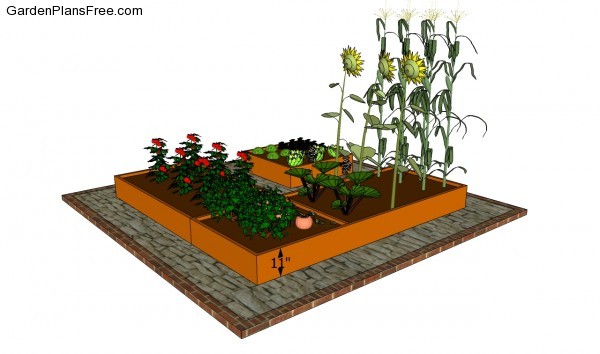Starting even a small garden will give you the opportunity to put fresh vegetables on you table every day. If you have a backyard that is exposed to sun for several hours a day, you should pay attention to this article. In addition, with a proper planning you could choose a small vegetable garden design that will add value to your property and you can turn you garden in an attraction point.
When starting a small vegetable garden, you should set the layout with great attention. Therefore, it is essential to select only the plants that you really like, as it is impossible to grow a great variety of vegetables in such a small surface. Grow the vegetables in blocks, according to their type and to how much moisture they need. In this manner, you will find it easier to take care of the plants and to use the space efficiently.
Small vegetable garden design

Small vegetable garden layout
When designing a small vegetable garden, you should take several aspects into consideration, if you want to maximize the space utilization as well as to easy your work. Therefore, you should make sure the garden beds are no wider than 4′, otherwise you won’t have a quick access to the plans without having to step on the soil.
PRO TIP: In addition, you should not make the raised beds longer than 10′, otherwise you will find it tiresome to go around the bed, when you need to go the other areas of your vegetable garden. In addition there are many layouts you could choose from, so make sure you study the alternatives.

Building a small vegetable garden
On the other hand, you need to leave enough space between the garden raised beds, otherwise you won’t have an easy access with a garden cart. Therefore, we recommend you to measure the width of the wheelbarrow or cart you are going to use. From our experience, anything over 20″ is a good choice, but we have designed this garden with 30″ wide pathways as to create a neat appearance.

Building the raised beds
It is essential to make the make the raised bed high enough. As you can see in the image, building the sides of the raised beds from two 2×6 slats or from one 2×12 piece of lumber is a good choice as it provides a great compromise between the amount of the materials needed and the variety of plants that could be grown in these conditions.
PRO TIP: Moreover, you should place the garden beds as to get the maximum amount of sunlight. If it is not possible due to the configuration of the yard, you can still grow several types of plats that will develop properly in these conditions (salad, spinach, broccoli).

Small vegetable garden plans
Last but not least, you should take care of the finishing touches. Therefore, we recommend you to check if the components are locked into place properly and if the frame is rigid. Make sure there are no protruding screws or sharp edges. Moreover, the components should be installed properly, making sure there are no gaps between the slats.
PRO TIP: Fill the holes with a good wood filler and smooth the surface with 120-grit sandpaper. Apply several coats of paint or stain over the components, in order to protect them from decay. Cover the pathways with bricks or a thick layer of bark chippings.
This diy project was about small vegetable garden plans. If you have enjoyed the free project, we recommend you to share it with your friends, by using the social media widgets.
